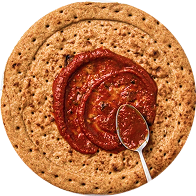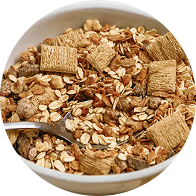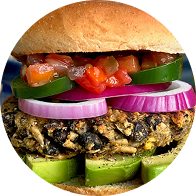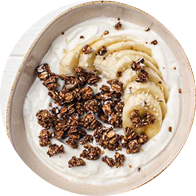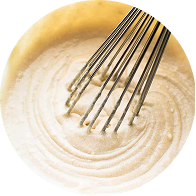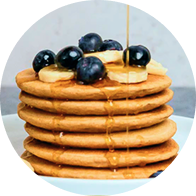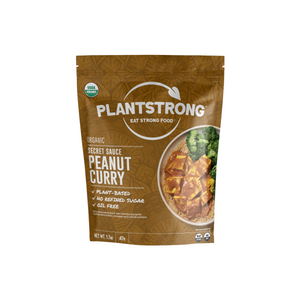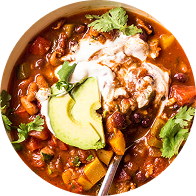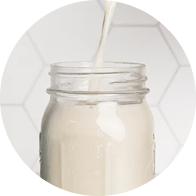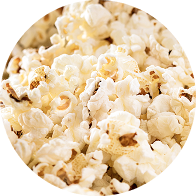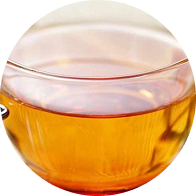Salt Intake & the Impact on Blood Pressure
Americans eat on average about 3,400 mg of sodium per day. However, the Dietary Guidelines for Americans recommends adults limit sodium intake to less than 2,300 mg per day—that’s equal to about 1 teaspoon of table salt! For children under age 14, recommended limits are even lower.. In fact, Within 30 minutes of eating excess salt, your blood vessels' ability to dilate is impaired, thus sending your blood pressure skyrocketing.
So, while that sodium number on the food label can seem harmless, it might actually be working against you. The good news is, we have some information on salt and blood pressure as well as tips on what you can do to decrease your sodium intake.
***Wondering what a day of PLANTSTRONG Products looks like from a sodium and calories perspective? We did a full day's analysis to show how easy it is to enjoy our products, paired with other whole plants, and stay well below the 1:1 ratio of milligrams of sodium to calories. You can view it HERE.

Salt and Your Blood Pressure
What Do the Blood Pressure Numbers Mean?
When getting your blood pressure taken you will get two numbers back. The first number is your systolic blood pressure. Systolic blood pressure is the measure of pressure in your arteries when your heart is actively pumping blood. The second number is diastolic blood pressure which is the pressure in your arteries when your heart is resting between beats. Understanding the relationship between these two numbers is important as you work to improve.
Which Blood Pressure Numbers are Recommended?
When looking at your blood pressure, it can be helpful to know what numbers are ideal. According to the American Heart Association, an adult should have a blood pressure below 120/80. When blood pressure is higher than 140/90 someone is considered as having a high blood pressure. However, damage can be done to your heart below this blood pressure number. It is best to keep this number in the lower numbers to truly protect and care for your heart.

Why is High Blood Pressure Bad for You?
High blood pressure has often been referred to as the “silent killer.” Also known as hypertension, high blood pressure is evidence that the heart is working too hard to move blood around. People with high blood pressure often won’t realize how hard their heart is working. High blood pressure can lead to heart attacks, strokes, and other organ failures. The good news is, there’s a simple way to bring down blood pressure and protect your overall health.
What Does Salt Have to do with Blood Pressure?
One of the first things eliminated when eating a heart healthy diet is salt. This is because salt encourages fluid retention in the body. Normally, your kidneys deploy a precise balance of potassium and sodium to remove extra water from the blood. When you consume too much salt, this balance of sodium to potassium is thrown off. Because of this, your kidneys will remove less water from your system.
This can put damaging pressure on your blood vessels in your kidneys and your arteries will bulge to accommodate the extra fluid. When tiny muscles in your arteries buff up in an attempt to support the extra pressure, the passageways become smaller and increases the plaque buildup.
Like a water main bursting under too much pressure, your arteries too can burst suddenly without warning. There are medications on the market that can reduce blood pressure, but fortunately, you can receive just as effective, if not better, results by cutting down on sodium intake.

Do We Just Eliminate Salt from Our Table?
Cutting down salt intake isn’t just about removing the salt shaker from the table. In fact, most of the salt consumption people have doesn’t from the salt added at the dinner table. Instead, the bulk of sodium intake in most diets comes from processed foods. Many processed foods will use sodium as a preservative to keep food fresher longer. In fact, you might be surprised to find out how many food items are hiding high sodium counts.
- Soups and Broths - Many soups and broths are filled with extra sodium. When trying to add flavor to soups and broths many companies will go to salt first. It is important to choose a low-sodium broth to prepare your next soup.
- Vegetable Juice - Vegetable juice is another hidden source of high sodium counts. Because vegetable juice is considered a healthy option, it isn’t an area you might expect to find higher sodium amounts.
- Salad Dressing - Many salad dressings you can find in the store are packed with excessive sodium as a preservative and also to add flavor to the dressing. It is important to check sodium labels when buying salad dressing. You might also consider making your own.
- Pizza - Pizza is a favorite option in most households. However, many of the ingredients are also packed with sodium. Use a low-sodium pizza kit to enjoy making pizzas you know will protect your heart!
- Boxed Potatoes - Boxed potatoes are often praised for their convenience. However, they are also a huge source of sodium. Preservatives are used to keep these potatoes fresh and ready to prepare. One of the key preservatives is salt.
- Chilis and Stews - Chili and stews that are sold at the store in cans are often filled with preservatives that can cause higher sodium levels in the meal. Use a low-sodium chili or stew to enjoy the food you enjoy without the high salt intake.
- Canned Vegetables - Canned vegetables are packed with extra salt. In fact, some brands of canned vegetables will have more than 13% of the recommended daily intake level. When possible, opt for fresh vegetables. Not only are they packed with nutrients, you will be able to control the amount of salt added to them.
- Sauces - When you are cutting down on sodium intake it can be wise to take a second look at your favorite sauces. Many sauces will be heavy handed on the salt when attempting to flavor the sauce. Try this new product from PLANTSTRONG.
- Frozen Meals - Frozen meals can hide a great deal of sodium. In fact, some will have half or more of your daily recommended salt intake in one meal. One of the best ways to avoid consuming these high sodium frozen meals is to cook extra when you cook dinner and freeze the excess for future meals.
The Importance of Reading Labels
New York Times bestselling author and PLANTSTRONG founder Rip Esselstyn is well-known for making this information simple to understand. In the video below he offers more on the dangerous effects of sodium on your body as well as how to read labels on your food to be sure you are not buying high-sodium foods.

